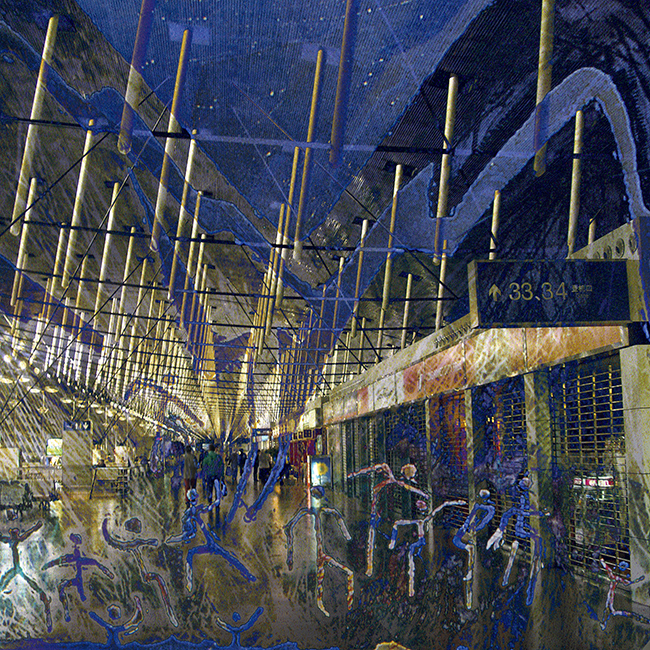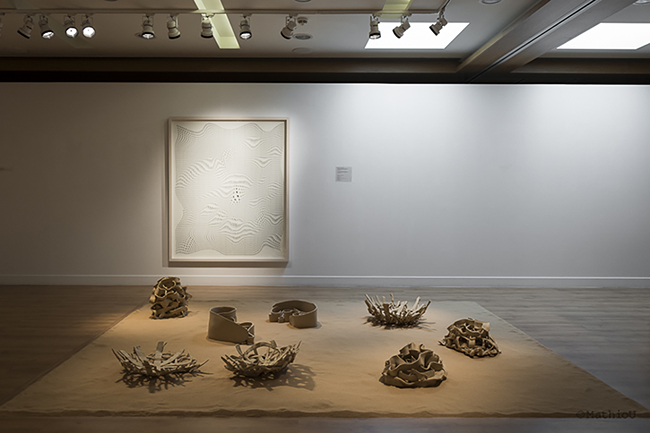Vicky Tsalamata’s La Comédie Humaine C explores the intricate balance of human existence, drawing on Honoré de Balzac’s classic work La Comédie Humaine. Through this lens, Tsalamata reflects on how unseen external forces—be they societal, historical, or technological—shape the way people experience life. Her project not only highlights this tension between individuality and larger systems but also places emphasis on the need for human connection, a need that has grown even more important in the wake of the COVID-19 pandemic.

Utilizing mixed media and archival prints on Photo Rag Hahnemuehle 100% cotton art paper, Tsalamata brings a tactile element to her examination of human connection. The delicate yet durable qualities of the materials mirror the duality of human relationships—strong yet fragile. Her figures, which are etched from iron matrices and sculpted with an acetylene flame, stand between 21 and 29 centimeters tall. The figures’ rawness, created through techniques like aquatint and dry point, embodies both the imperfections and resilience of humanity.
One of the most intriguing aspects of Tsalamata’s approach is the way she delves beneath the surface, quite literally, to expose hidden details in her work. Using high-resolution scanners, she captures elements that are otherwise invisible, bringing to light subtle connections that would be missed by the naked eye. These intricacies form a visual metaphor for the unseen bonds between individuals, hinting at how deeply interconnected our lives truly are—even if we’re unaware of it.

At the heart of La Comédie Humaine C is the exploration of how isolation and connection coexist. Tsalamata uses her etched figures to illustrate the intricate web of relationships that form the foundation of human life, and how these connections have been altered in a world increasingly dominated by digital technology. The work reflects on how platforms like social media have changed the way we communicate and form relationships, making it easier to connect yet also highlighting the fragility of those connections.
The project has garnered attention for its contemporary relevance and will be showcased at the Sixth Cacak International Printmaking Biennial in 2024. Tsalamata’s concept of “Synapsis,” which she describes in her artist’s statement, speaks to the unseen networks that bind human relationships together. For her, these networks operate much like a biological organism, influencing not only our social interactions but also our mental and emotional well-being.

As much as La Comédie Humaine C is an exploration of human relationships, it also serves as a critique of the digital age. Tsalamata raises important questions about how digital tools have changed the nature of personal connection. While technology has made it easier for us to stay in touch, it has also introduced new complexities into how we relate to one another. Her work challenges viewers to reflect on how these changes impact our sense of belonging and community.
In combining traditional printmaking techniques with modern scanning technology, Tsalamata creates a layered, multifaceted narrative. Her use of archival materials and intricate techniques makes her work feel timeless while addressing very current themes. The tension between the tactile, physical process of printmaking and the invisible, digital world we now inhabit is palpable in her work, offering a thoughtful reflection on how these two worlds intersect.
Through La Comédie Humaine C, Tsalamata presents a nuanced view of how humans connect and how these connections are influenced by the world around us. Her figures, etched from iron and meticulously detailed, stand as symbols of the complexity of human interaction. Whether highlighting the bonds we share or the barriers that divide us, her work invites viewers to consider the often-invisible forces shaping our relationships. Tsalamata’s ability to weave together different mediums and ideas results in a profound exploration of the human condition, encouraging us to think about how we navigate our place within a larger, interconnected world.

